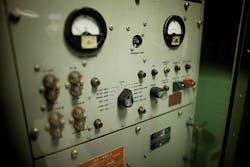Navy eyes open industry competition for high-power transducers in underwater communications system
Officials of the Naval Undersea Warfare Center (NUWC) in Newport, R.I., announced plans Monday to release a formal solicitation later this month for the TR-232C Transducers project to manufacture, test, inspect, package, and deliver TR-232C transducers, TR-232C connectors, and TR-232 boots.
The TR-232 performs the high-power, low frequency transducer function for the Navy's AN/WQC-2A underwater sonar communication system, which is in-use on more than 600 naval surface ships and submarines worldwide. The transducer is a piezoelectric design and features a horizontal radial omni-directional beam pattern.
NUWC officials say they will issue a formal solicitation (N66604-18-R-0136) for the TR-232C transducer around 29 Nov. 2017. The contract will be a follow-on to a $10.1 million contract awarded in 1999 to EDO Electro-Ceramic Products in Salt Lake City, which now is part of Harris Corp.
Related: Navy chooses adhesive from Alfa International for underwater transducers and hydrophones
The AN/WQC-2A sonar communication set, of which the TR-232C transducers are a part, is a single sideband, general-purpose voice and continuous-wave communication set that functions as an underwater communications system to link surface ships, submarines, and coastal-based shore stations.
Test range sites and other coastal installations also use the AN/WQC-2A to communicate with nearby vessels. This system is installed on most U.S. Navy surface ships and submarines. It transmits and receives voice, audio, and low-speed telegraphy for short- and long-distance underwater communications.
The set also can be used to amplify and transmit signals from external sources. Ultra Electronics Ocean Systems in Braintree, Mass., is a longtime supplier of the AN/WQC-2A, with more than 300 sonar sets produced for the U.S. Navy and foreign customers, company officials say.
The AN/WQC-2A consists of a control station, a remote control station, a receiver-transmitter, as well as low- and high-frequency transducers.
Related: Curtiss-Wright Flight Systems supplies transducers for military helicopter avionics
The TR-232C transducer, which the Navy will offer to users as government-furnished equipment, are for all classes of submarines and select surface ships -- especially Navy aircraft carriers, cruisers, destroyers, frigates, and mine-countermeasures vessels.
A transducer converts electrical energy to sound, and sound back to electrical energy. Essentially it acts as a loudspeaker and microphone to enable naval vessels to talk to one another through the water. Transducers also are essential elements of Navy sonar systems by transmitting sonar sound pulses through the water and listening for returning sound echoes that suggests the presence of an enemy submarine or other target of interest.
The Navy will issue the TR-232C solicitation on a 100 percent small business set-aside to small businesses with the technical capability, facilities, equipment, and qualifications to produce the TR-232C transducer.
More information is online at https://www.fbo.gov/spg/DON/NAVSEA/N66604/N66604-18-R-0136/listing.html. Email questions or concerns to the Navy's Rosemary Shuman at [email protected].
Ready to make a purchase? Search the Military & Aerospace Electronics Buyer's Guide for companies, new products, press releases, and videos
